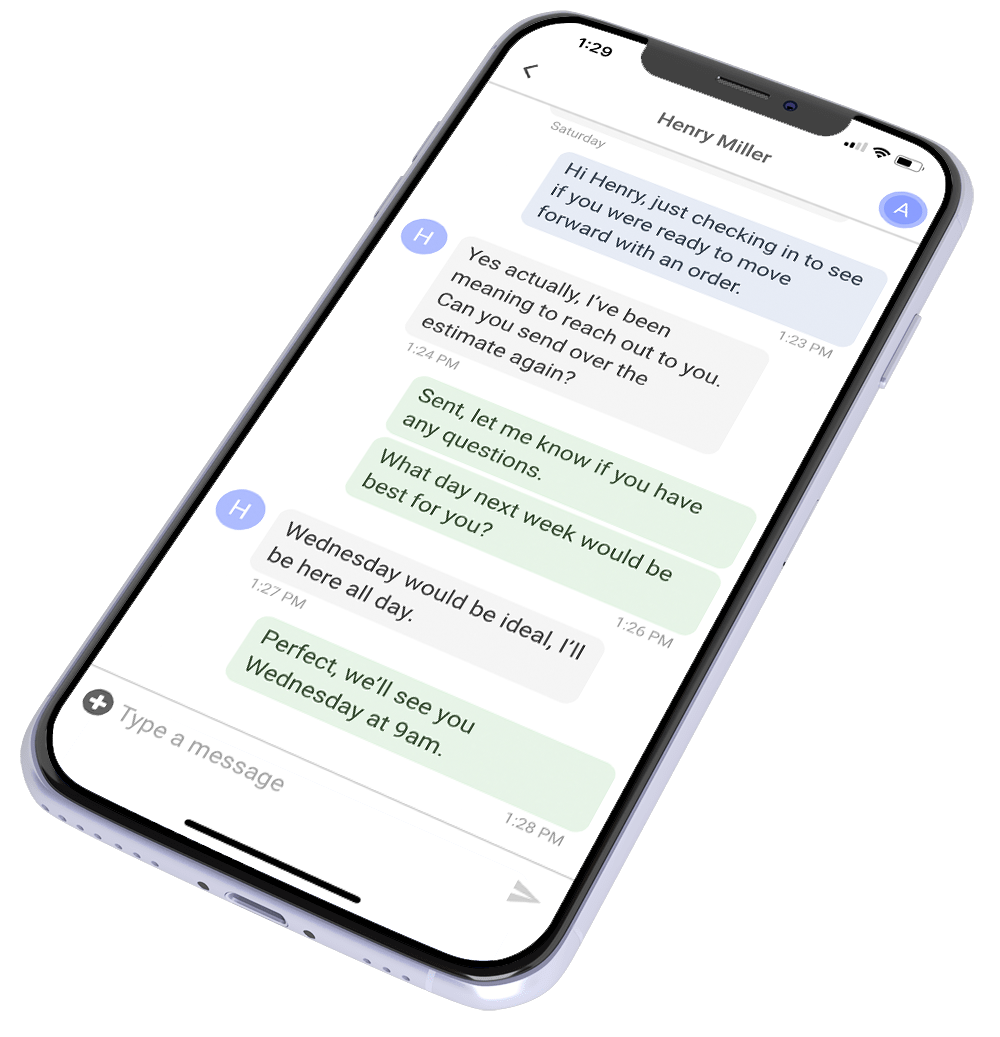This Roofing CRM Features Tier List breaks down the tools that help roofers close more jobs, follow up faster, and avoid features that just waste time.
James, our Head of Sales, just dropped a YouTube video breaking down roofing CRM features. He’s seen too many roofers get burned by bloated software that overpromises and underdelivers. So, he cut through the noise and ranked every CRM feature into three buckets: must-haves, nice-to-haves, and overrated gimmicks.
Here’s the gist: If a CRM doesn’t help you close jobs, follow up faster, or get paid, it’s dead weight. Fancy dashboards and integrations sound great, but if they don’t move the needle, why waste time? James covers the non-negotiable features that actually drive sales, the ones that are handy but not game-changers, and the ones that software companies push just to jack up the price.
Think your CRM holds up? Or is it slowing you down? Check out James’ feature hot takes and see if your system makes the cut. Let’s dive in.
What Is a Roofing CRM (And Why You Need One)?
What a CRM Does (and Doesn’t Do)
Roofers don’t need more software. They need the right software. A CRM—short for Customer Relationship Management—should track every lead, send every quote, and keep every customer close. If a CRM can’t manage customer relationships automatically or with less effort, it fails at its only job.
Some tools call themselves a CRM but don’t actually do CRM work. A production tool tracks jobs. A finance tool tracks money. A spreadsheet tracks chaos. None of those help land the next deal. A real CRM handles every touchpoint with homeowners, from the first call to the final invoice.
The True Job of a CRM in Roofing
Speed wins jobs. The first roofer to respond, follow up, and send a quote gets the deal. A CRM should remove delays, not add them. Every customer expects a quick answer. A strong CRM automates follow-ups, keeps every text, call, and email in one place, and makes sure no lead gets lost.
Slow quotes lose business. If a CRM can’t send a proposal in minutes, it holds the sales team back. Roofers need instant quoting, built-in payment links, and reminders that chase down unpaid invoices.
The wrong CRM isn’t just a hassle—it’s a sales killer. Too many clicks, missing features, and messy systems cost time and money. Roofers don’t have time to babysit software. The CRM should work for them, not the other way around.
How We Ranked CRM Features
The Two-Question Test for Every Feature
A CRM should pull its weight. Every feature in the system needs to serve a real purpose. If it doesn’t, it clutters the workflow, slows down deals, and wastes time.
Every feature in this ranking passes a two-question test. First, does it help manage customer relationships automatically or with less effort? Second, does it speed up the sales process, communication, or collections? If the answer to both is yes, the feature holds real value.
A CRM must help close deals, move projects forward, and keep customers engaged. Anything that slows down that process belongs in a different tool.
The Three-Tier Ranking System
Some features make a business stronger. Others bring a little extra convenience. A few do nothing but take up space. Every CRM tool lands in one of three buckets.
Must-Have: These features drive revenue. They help reach leads faster, close jobs sooner, and get paid without delays. Without them, a CRM leaves money on the table.
Nice-to-Have: These add efficiency but won’t make or break the business. They provide small wins, but if they disappear tomorrow, operations keep moving.
Overrated or Unnecessary: These look good on a demo but don’t improve customer relationships. They add buttons, tabs, and distractions without boosting sales or efficiency.
A strong CRM focuses on what matters. This ranking cuts through the noise and points out the tools that actually help roofers win more jobs.
Read: The Worst Roofing CRM Software Mistakes to Avoid 2025

Must-Have CRM Features (Non-Negotiable for Success)
A strong CRM makes sales faster, keeps customers engaged, and moves work forward. Every feature in this section brings real results. Without them, leads go cold, quotes get ignored, and jobs slip through the cracks.
Communication (1:1 at Scale)
No roofer wins jobs without talking to customers. A CRM must handle texts, calls, and emails without delay. It must send reminders, follow-ups, and updates automatically. A good system keeps every message in one place, so nothing gets lost.
Homeowners pick the first roofer who answers. A slow response kills deals. A strong CRM fires off a text when a lead comes in, schedules a call, and follows up without a second thought. Every second counts.
Quoting & Proposals (Directly Inside the CRM)
A quote sitting in an email draft doesn’t close deals. A CRM should generate, send, and track proposals without extra steps. If a customer has to wait, they move on.
Multi-option quoting gives homeowners choices. Show retail customers standard, premium, and high-end packages. For insurance work, match the adjuster’s price and upsell upgrades. When options hit their inbox fast, they sign faster.
Follow-ups should run on autopilot. A CRM must remind customers, chase down unsigned quotes, and keep deals moving. If a proposal sits too long, a CRM should know and act. Roofers should focus on the next job, not babysitting old ones.
Read: ProLine’s Free Roofing CRM Explained
Sales & Follow-Up Automation
Leads don’t close themselves. Customers forget, get busy, or second-guess their choices. A CRM must handle follow-ups without the sales team lifting a finger. Every missed follow-up means another job lost.
A strong CRM knows when to send a message. A new lead comes in? It fires off a text. A quote sits unsigned? It nudges the homeowner. A customer drags their feet on payment? It sends a polite but firm reminder. The system works 24/7, so deals keep moving even when no one’s watching.
Reps should focus on selling, not chasing paperwork. A CRM should follow up like the best sales assistant on the team. It should schedule reminders, queue up calls, and send emails from the rep’s own number or inbox. Customers respond when the message comes from a person, not a random company address.
Mobile App (A CRM Without One Falls Flat)
Roofers work in the field, not at a desk. A CRM must fit in a pocket, load fast, and run like a well-oiled machine. If it forces reps to log in from a truck laptop or call the office for updates, it fails the test.
A strong mobile app does more than show a dashboard. It must let users text, call, send quotes, collect payments, and update jobs in real time. Every second wasted on slow software costs money. The right CRM makes sure crews, sales reps, and office staff stay on the same page—wherever the job takes them.
Job Boards & Internal Team Communication
Chaos kills efficiency. A strong CRM keeps every job, every crew, and every update in one place. No more chasing down details. No more “Where’s that job at?” calls.
A job board should show the full picture. Sales reps see which jobs need follow-up. The office sees what’s booked, in progress, or wrapped up. Crews see where to go and what to do when they get there. Everyone works with the same playbook.
Tracking job status keeps customers in the loop. Nobody likes surprise delays. Homeowners want updates before they ask for them. A CRM should mark key milestones—material delivery, crew arrival, final walkthrough—and send updates automatically. That builds trust. Fewer callbacks, fewer complaints, more referrals.
Invoicing & Payment Processing
Money should flow as smoothly as the work. Invoicing should happen the moment a job finishes. A CRM should send the invoice, track the status, and remind the customer until the payment lands.
Homeowners pay faster when the process stays simple. No extra logins. No digging through emails for payment links. A CRM should let them pay by card, ACH, or financing with a single click.
Late payments drain cash flow. A strong CRM chases them down automatically. First, a friendly nudge. Then, a firmer reminder. No one on the team should waste time tracking down money. The system should do it for them.
Nice-to-Have CRM Features (Useful, But Not Essential)
Some CRM features make life easier. They add convenience, but they don’t close deals. A strong CRM focuses on the must-haves first. These extras help, but they won’t make or break the business.
Document Storage
A CRM with document storage keeps everything in one place. Contracts, insurance paperwork, and permits stay linked to each job. No more digging through emails or shared drives.
But does document storage help close deals? Not really. Sales reps win jobs with fast quotes and follow-ups, not file management. Cloud storage tools like Google Drive or Dropbox work just as well for keeping documents organized.
Reporting & Analytics
Numbers tell a story. A CRM should track how many leads come in, how fast reps respond, and how many jobs close. Good reports help spot trends and make smarter moves.
But reports don’t sell roofs. A sales team wins more jobs by following up, not by reading spreadsheets. Real-time data works best. A CRM should show which leads need action today, not just last quarter’s numbers.
Customer Portal
Some CRMs offer portals where customers log in, check quotes, and track jobs. That sounds good in theory. In practice, most homeowners ignore them.
People read texts and emails. A CRM should focus on sending updates where customers already look. Simple tools like automated messages and scheduled calls do the same job without making customers jump through hoops.
Social Media Integration
Some CRMs let businesses post to Facebook, Instagram, and other platforms. It sounds useful. It rarely moves the needle.
Homeowners don’t scroll social media looking for a roofer. They search Google, check reviews, and call the first company that looks legit. A CRM should focus on fast responses, automated follow-ups, and simple quoting—the things that actually close jobs.
Want to handle social media the right way? Use a dedicated tool. Platforms like Facebook Business Suite, Hootsuite, or Buffer schedule posts, track comments, and manage ads better than any CRM ever will. Keep social engagement where it belongs and let the CRM focus on turning leads into sales.
Canvassing Tools
Canvassing works. Knocking on doors, meeting homeowners face-to-face, and working storm-damaged neighborhoods bring in jobs. But CRMs handle sales, not boots-on-the-ground prospecting.
A strong canvassing tool maps neighborhoods, tracks doors knocked, and logs conversations. It should help canvassers see where they’ve been and who showed interest. Apps like Spotio or SalesRabbit specialize in this. They do it better than any CRM ever could.
Instead of forcing canvassing into a CRM, connect the two. A canvassing app should feed leads straight into the CRM. Once a rep knocks on a door and gets a homeowner’s info, the CRM should trigger follow-ups, send quotes, and keep the lead warm.
Let each tool do what it does best. The CRM should sell. The canvassing tool should track doors. Together, they work like a well-trained crew—each handling their job without stepping on the other.
Overrated or Unnecessary CRM Features
Some CRM features sound good on paper but don’t help close more deals. James, our Head of Sales, has spent years working with roofers, and he’s seen which tools actually make a difference. ProLine has supplier integrations, material orders, budgeting, and QuickBooks integration, but James doesn’t put these in the must-have category. They’re useful, but they won’t book more jobs.
Supplier Integrations & Material Orders
Ordering materials inside a CRM looks like a time-saver. In reality, most roofers still call their rep or submit an order through the supplier’s portal. A CRM can track orders, but it doesn’t improve customer relationships or close deals faster.
ProLine has supplier integrations and material order tracking, but James doesn’t rank them as must-haves. A CRM should focus on selling jobs and keeping customers engaged. Material ordering still works best when handled directly with the supplier.
Budgeting & QuickBooks Integration
Roofers ask about QuickBooks integration all the time. ProLine has it. So does every serious CRM. But does it increase close rates? No. Budgeting and accounting belong in QuickBooks or another dedicated tool.
ProLine tracks invoices, payments, and cash flow because those keep the business moving. It connects with QuickBooks, but it doesn’t turn into an accounting platform. James puts it like this: focus on sales first, cash flow second, and let the accountants handle the books. A CRM’s job is to drive revenue, not track every dollar spent.
Conclusion & Next Steps
A CRM should help close more jobs, follow up faster, and keep cash flowing. Every feature inside it should serve that purpose. Anything that slows down sales or clutters the process belongs somewhere else.
James has seen too many roofers get stuck with the wrong system—either too basic to help or too bloated to use. ProLine gives roofers the right tools without the extra baggage. Fast communication, instant quoting, automated follow-ups, job tracking, and invoicing all work together to land more deals and collect money faster.
If your CRM wastes time, drops leads, or makes sales harder, it’s time to move on. The right system should make running a roofing business easier, not add to the headache. Book a demo, see ProLine in action, and get the tools built to help roofers win.
Check out ProLine’s overview video to see how it helps roofers close more deals and streamline operations: Watch here.
Want to see ProLine in action? Book a demo and find out how it can help you sell more roofing jobs: Schedule a demo.
Looking for the best CRM for your business? Check out our guide to the top 8 roofing CRMs for residential roofers: Read the guide.



